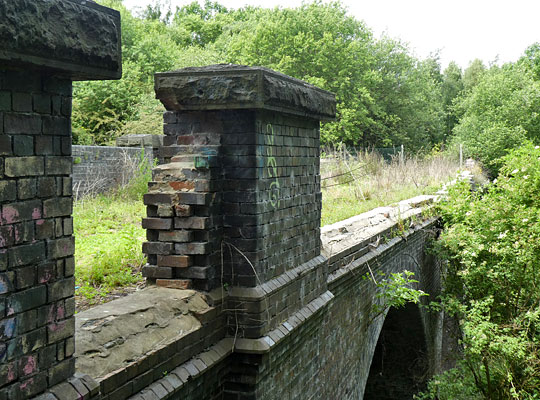Intersection bridge
Intersection bridge




















Like many others, the Lancashire, Derbyshire & East Coast Railway had foundations built on coal. When plans were developed to establish collieries on his estate in the 1880s, William Arkwright determined that the best way to fully exploit them was by laying an independent railway, driving eastwards and westwards from his seat near Chesterfield. The original Act authorised a main line from Warrington to Sutton-on-Sea, an extensive network of branches and a new docks complex.
Landowners generally welcomed the plans and Arkwright acquired rights to the proposed Newark & Ollerton Railway to form the core of his new line. Whilst Robert Elliot-Cooper, a preeminent civil engineer, was appointed to take charge of construction, critical to achieving corporate success was Emerson Bainbridge, himself a distinguished engineer and local mining mogul who advised on the best route. He had immediately seen the potential behind Arkwright’s big idea.
The railway emerged from its Parliamentary passage in August 1891; however the associated euphoria soon subsided when the necessary capital proved difficult to secure. The Great Eastern Railway stepped in, seeing an opportunity to cut itself a slice of the region’s lucrative mineral traffic. The price was a severe curtailing of the scheme, with activity focussed only on the line’s central section, connecting Chesterfield to the Great Northern & Great Eastern Joint Railway at Pyewipe, as well as an 11-mile branch to Beighton, south-east of Sheffield.
Ground was broken in Chesterfield on 7th June 1892, the work having been divided into three contractual parts. By far the heaviest was that secured by Messrs S Pearson & Son; this comprised the Chesterfield-Warsop section – including several viaducts and more than 3,100 yards of tunnel – as well as the Beighton branch. The latter, which pushed northwards from Langwith Junction, was key to capitalising on Sheffield’s heavy industry.
As late as 1896, the branch looked set to terminate in the middle of nowhere. However that year saw an Act passed for construction of the Sheffield District Railway, diverging from the Beighton branch near Barlborough to reach Attercliffe, the city’s northern industrial centre. The Midland Railway then intervened, offering the use of its metals for part of the route and creating a connection to Attercliffe at greatly reduced costs. The Beighton branch suddenly assumed strategic importance.
Its northernmost 1½ miles had to cross the Chesterfield Canal, Sheffield Road, the River Rother and two railways – the Midland’s Killamarsh branch and the Waleswood curve. The latter was opened by the Manchester, Sheffield & Lincolnshire Railway in 1893; spanning it was Bridge 147 – known as the Intersection bridge – now licking its wounds in a woodland oasis alongside Rother Valley Country Park.
The structure comprises a skewed metal span supported by abutments in blue engineering brick with masonry bearing stones. The deck plates have been removed, leaving a latticework of cross girders and longitudinal beams, all transferring load into the main girders. The paintwork is missing in small patches, resulting in light to medium corrosion. Several waybeams – to which the rails were fixed – remain in situ.
At the abutment, the approach embankment is retained by triangular wing walls. The smaller of the two, on the west side, is diagonally fractured whilst a tree blights the larger east-side wing wall, taking root beneath the copers and lifting them by as much as 100mm. The newel post is also missing.
South of the main span are three arches over a gulley, each having five rings of engineering brick. The spandrels are being pushed out slightly; there is also some cracking and open joints. Once again, a tree and vegetation growth are partly responsible for the defects.
Most of the parapet on the east side has been lost down to track level, debris lying in piles below the arches. On the west side, the copers and upper few courses have gone above the two northern spans.
Aesthetically, the structure enjoys neat detailing, with a stepped string course and rounded quoins to the piers, pilasters and inner arch ring.
Trains first tested the bridge in 1900; however the section of line over it closed to traffic when Westthorpe Colliery was shut on 12th October 1984.
To the north of Spinkhill Tunnel, much of the LD&ECR’s former trackbed can still be walked unofficially, although the vegetation gets particularly thick in the summer. The condition of Bridge 147 has resulted in it being fenced off at both ends.







